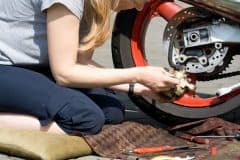Easy Tips to Prep Your Motorcycle for Summer Riding
With spring here and summer around the corner, this is the season when riders head out on their bikes and start riding again. Accidents between cars and motorcycles increase in summer months. Because of this, extra vigilance is required (and motorcycle insurance is recommended!) when out on your summer ride. Whether you’re planning a short ride or an epic road trip, here are some things that all riders need to know to prepare for summer, stay safe, and make your trip as smooth as possible:
What to know before you go:
Most states require riders to take an authorized motorcycle training course, as well as passing both written and “behind the wheel” driving exams to earn their motorcycle license. Also, most states require riders to wear an approved helmet. Check with your local DMV for the rules of the road in your state.
Once you have earned your license and purchased your helmet, you’re ready to give your bike a summer tune up! If you put your motorcycle away properly last fall, it should take minimal effort to bring it back to life. It’s imperative to check out your bike after a dormant winter to keep it in good working order. With the help of an owner’s manual, you won’t need mad skills to perform most of these tasks.
Check out these 8 components:
Fuel System
If the gas in your tank is old, resist starting your motorcycle. Instead, drain the old fuel from the tank (and drain the carburetors if needed). This can prevent stale gas from circulating through the system. If your bike runs poorly even after draining, consult a mechanic.
Engine Fluids
Check the oil, or change the oil and filter if you didn’t do it before storing your bike away. Old engine oil contains acids that can damage your ride. If your bike is liquid-cooled, check coolant levels, including the fluid in your overflow tank.
Air Filter
Check your air filter, as rodents enjoy building nests in small spaces. Remove any debris and replace the filter if it looks dirty.
Lights, Cables, and Fasteners
Be sure to check that all of your lights operate. Confirm that the throttle, clutch and brake cables operate smoothly before heading out. Walk around the whole bike, and tighten all fasteners.
Tires
Tire pressure will drop significantly over the winter – low pressure can affect handling, so be sure to check this before you roll out. If the tread is worn or if the tires show any signs of rot, now’s a good time to replace the tires.
Drive Train
Check for drive train wear –Sprockets should show no signs of hooking and the chain should not pull very far away from the back of the sprocket. Replace the chain and sprockets as a set if necessary. If all looks good, check the adjustment and give the chain a lube.
Battery
Weak or dead batteries are another common issue. Hopefully you kept your battery charged. If not, you will likely have to charge the battery before it will start. If it will not hold a charge, a new battery is your best bet.
Brakes
It is vitally important that you maintain your brakes. Squeeze the front brake lever and press on the rear brake pedal. Inspect the brake master cylinders to see that brake-fluid levels are good. If the fluid is the color of apple juice or darker, replace it. With a flashlight, take a look at your front and rear brake calipers to see how much brake pad material there is remaining. If in doubt, have the pads replaced. It could save your life.
Defensive driving applies to bikers, too!
Even if you carry the “crème de la crème” of motorcycle insurance, defense driving is still a must!
Keep the following in mind when out on your ride:
- Always assume that drivers don’t see you – Motorcycles can disappear in motor vehicle drivers’ blind spots – don’t become a statistic!
- Keep your distance – Motorcycles have shorter stopping distances than larger vehicles, so always give the cars and trucks on the road a bit of extra distance in the event a sudden stoppage causes you to brake.
- Avoid quick movements – Motorcyclists often change positions within and between lanes to avoid traffic and/or collisions. When you plan to change lanes, be sure to use your turn signals to alert all the larger vehicles around you of your intentions.
- Never ride faster or farther than conditions permit – this could prevent you from harm. Go with your gut and trust your instincts.
Finally, you’re ready to rumble – Have a safe ride!
Looking for cheap motorcycle insurance that will keep you safe on the road? Freeway Insurance has some of the best motorcycle rates available. Call us for a free quote today!



